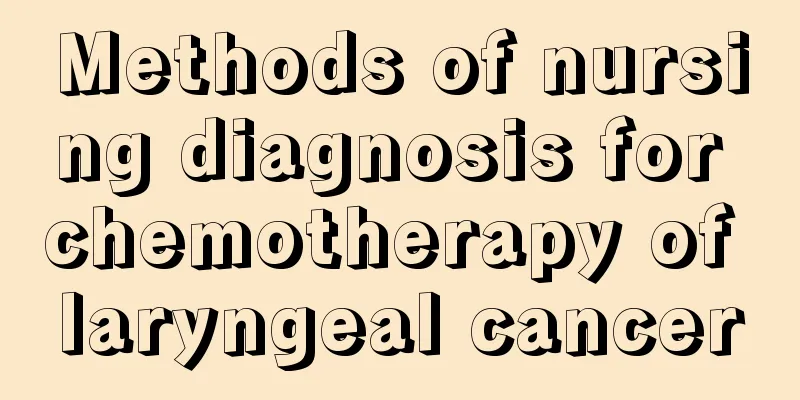Methods of nursing diagnosis for chemotherapy of laryngeal cancer

|
Many diseases need to be treated by surgery, especially cancer. Surgery is the best treatment method, but it also causes great harm to the patient's body. There are certain risks in surgery for laryngeal cancer patients, and postoperative recovery is also very important. Therefore, nursing is very important for patients, especially psychological counseling for patients. In order for patients to survive the most difficult times, we must do a good job of nursing. The following is the nursing practice for laryngeal cancer patients, you can learn from it. (1) Before total laryngectomy, the doctor should do a good job of ideological work with the patient and his family, explain the necessity of surgical treatment, and ask the patient (the patient who will be examined after surgery) to share his own experience, explaining that he can practice pronunciation or use an artificial larynx after surgery to solve the problem of postoperative language communication. This will eliminate the patient's concerns about the surgery. Instruct the patient not to swallow within one week after laryngectomy to promote wound healing, and ask the patient to prepare paper and pen or pictures, as well as gestures to express needs before the operation. Start gargling with Dobel solution 3 days before the operation, 4 times a day. If there is a dental disease, it should be treated. (2) After the operation, the patient should be nursed according to general anesthesia and the changes in blood pressure, pulse, respiration and body temperature should be closely observed. After the patient wakes up from anesthesia and the blood pressure stabilizes, the patient should be placed in a semi-recumbent position. The patient undergoing laryngoplasty should lie flat with the head forward to reduce the tension on the anastomosis. (3) Follow the tracheotomy care and perform aseptic operation techniques to prevent wound contamination, keep the airway open, aspirate tracheal secretions at any time, maintain the indoor relative humidity at 50% to 60%, and, if necessary, perform nebulization 2 to 3 times a day, or add 1 to 2 drops of 1% sodium bicarbonate to the tracheal tube to reduce phlegm and prevent phlegm crust from blocking the tube and causing suffocation. For patients who have undergone partial laryngectomy, the laces must be tied tightly to prevent the tube from falling off and causing breathing difficulties for the patient. The tracheal tube should be cleaned four times a day. (4) Observe the bleeding tendency. If the neck blood vessel ligature is found to be slipping or the innominate vein or artery is found to be ruptured and bleeding, apply pressure to the bleeding point immediately, report to the doctor immediately and actively cooperate with the rescue. (5) After surgery, it is strictly forbidden to eat or drink anything. Do not swallow saliva. Keep the oral cavity clean. Starting from the third day after surgery, rinse the mouth frequently with Dobel solution or 1.5 ml hydrogen peroxide to promote wound healing. Pay attention to whether the wound has exudation and bleeding, pay attention to changes in body temperature, and prevent anastomotic fistula. (6) Nasogastric feeding of mixed milk diet for 7-10 days, 4-5 times a day, 500 ml each time. After the infusion, inject 200-300 ml of warm water to maintain adequate water and prevent the stomach tube from being blocked or dislodged. When starting to eat, instruct the patient to chew slowly. Patients with partial laryngectomy should first eat sticky semi-fluid food to prevent it from entering the trachea and causing choking. (7) After cervical lymph node dissection, when the drainage is connected to negative pressure suction, keep the drainage unobstructed to promote wound healing. (8) Training esophageal pronunciation. After the wound heals, the patient should attend an esophageal pronunciation class. The patient can swallow a breath and store it in the esophagus, then slowly expel it and make a burp sound. Pay attention to the coordination of the abdominal and chest movements, esophageal burping movements, and mouth shape movements to make sounds. Regular training is sufficient to maintain daily life needs. (9) Before discharge, patients should be taught how to suction sputum and use cannulas and laryngeal pads. Even patients who have undergone total laryngectomy should wear cannulas to prevent stenosis of the stoma (tracheostomy). Patients should also be advised to prevent constipation, maintain smooth bowel movements, avoid physical labor, take precautions against colds and flu, avoid catching cold, and come to the hospital for regular checkups. (10) Patients who receive radiotherapy alone may suffer from breathing difficulties or even suffocation due to tumor compression or laryngeal edema. Therefore, emergency items such as tracheotomy trays, suction devices, and oxygen should be prepared at all times. The above are all the precautions for laryngeal cancer patients after surgery. They are very important for patients. I hope that patients and their families will study them carefully and try to provide patients with a good recovery environment. Only with a good environment can patients have a positive attitude, which is more conducive to recovery, and patients can have more faith to defeat the disease. I hope every patient can be healthy and happy. |
<<: Method of indirect laryngoscopy for diagnosis of laryngeal cancer
>>: Nursing diagnosis after laryngeal cancer surgery
Recommend
Six signs to help you find invisible cancer
Many people find out they have cancer when it is ...
Can the pacifier be scalded with boiling water?
Pacifiers are a tool that many babies will use. T...
What to eat is good for hair? 7 key foods that can make your hair grow thicker
Aging, work and study pressure, and irregular lif...
Nursing of Bone Metastasis of Lung Cancer
Lung cancer is not only a common disease in our c...
What is the principle of scraping
We all know that scraping can have a very good he...
What are the symptoms of tenosynovitis?
There are two common types of tenosynovitis. The ...
What are the methods to prevent liver cancer? This fish is the most effective in preventing liver cancer
According to Science and Technology Daily, a surv...
At what age should the cervical cancer vaccine be given
The best age for cervical cancer vaccination is g...
What are the benefits of tea water
Tea is a kind of drink in our lives, and it is al...
How to prevent bladder cancer
Bladder cancer has a high incidence in our daily ...
What does the biochemical test check?
Biochemical examination is a very important means...
What are the symptoms of gastric cancer? Pay attention to these symptoms
With the deterioration of the living environment ...
Does eating bitter melon after a meal really help you lose weight?
Bitter melon is the most common cooling food on t...
Causes of pancreatic cancer
There is a type of cancer called pancreatic cance...
Can I exercise with fibroids?
The answer to the question of whether patients wi...









